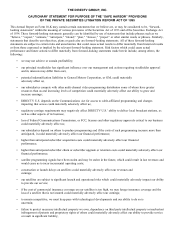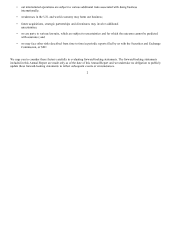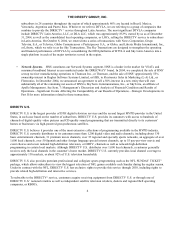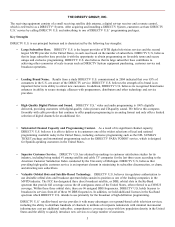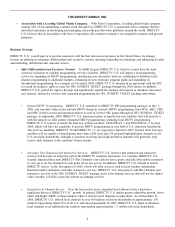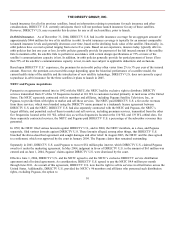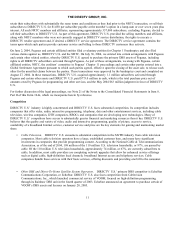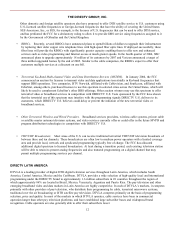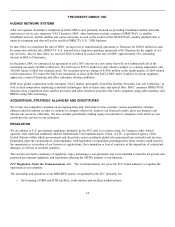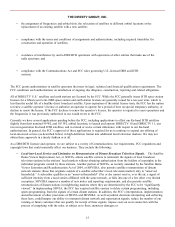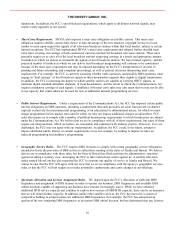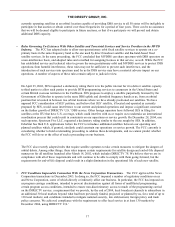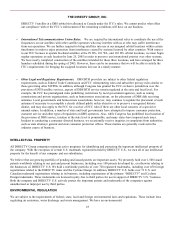DIRECTV 2004 Annual Report Download - page 20
Download and view the complete annual report
Please find page 20 of the 2004 DIRECTV annual report below. You can navigate through the pages in the report by either clicking on the pages listed below, or by using the keyword search tool below to find specific information within the annual report.
THE DIRECTV GROUP, INC.
retain their subscribers with substantially the same terms and conditions as they had prior to the NRTC transaction, or sell their
subscribers to DIRECTV U.S. for $1,050 per subscriber payable at the member’s option in a lump-sum or over seven years plus
interest. All such NRTC members and affiliates, representing approximately 357,000 subscribers, excluding Pegasus, elected to
sell their subscribers to DIRECTV U.S. As part of this agreement, DIRECTV U.S. provided the selling members and affiliates,
along with NRTC members who were not currently engaged in DIRECTV service distribution, the rights to execute a
DIRECTV retailer agreement and, if desired, a DIRECTV service agreement. The DIRECTV service agreement contains the
terms upon which such parties provide customer service and billing to those DIRECTV customers they activate.
On June 2, 2004, Pegasus and certain affiliated entities filed a voluntary petition for Chapter 11 bankruptcy and also filed
various claims against us, DIRECTV U.S. and the NRTC. On July 30, 2004, we entered into certain arrangements with Pegasus
and certain other related entities, whereby DIRECTV U.S. agreed to purchase the primary DBS assets of Pegasus, including
rights to all DIRECTV subscribers activated through Pegasus. As part of these arrangements, we along with Pegasus, certain
affiliated entities, NRTC, the creditors’ committee in Pegasus’ Chapter 11 proceedings and certain other parties entered into a
Global Settlement Agreement pursuant to which such parties agreed, effective upon the closing of the asset sale, to release each
other for the unsettled claims between the parties. These transactions were approved by the bankruptcy court and completed on
August 27, 2004. In these transactions, DIRECTV U.S. acquired approximately 1.1 million subscribers activated through
Pegasus and certain other assets and DIRECTV U.S. paid $773.0 million in cash, which is the total purchase price net of
amounts owed by Pegasus for programming and other services, and the May 2004 $63 million judgment in favor of DIRECTV
U.S.
For further discussion of the legal proceedings, see Note 21 of the Notes to the Consolidated Financial Statements in Item 8,
Part II of this Form 10-K, which we incorporate herein by reference.
Competition
DIRECTV U.S.’ industry is highly concentrated and DIRECTV U.S. faces substantial competition. Its competition includes
companies that offer video, audio, interactive programming, telephony, data and other entertainment services, including cable
television, wireless companies, DTH companies, RBOCs and companies that are developing new technologies. Many of
DIRECTV U.S.’ competitors have access to substantially greater financial and marketing resources than it has. DIRECTV U.S.
believes that the quality and variety of video, audio and interactive programming, quality of picture, access to service,
availability of a broadband Internet service, customer service and price are the key elements for gaining and maintaining market
share.
•
Cable Television. DIRECTV U.S. encounters substantial competition in the MVPD industry from cable television
companies. Most cable television operators have a large, established customer base, and many have significant
investments in companies that provide programming content. According to the National Cable & Telecommunications
Association, as of the end of 2004, 108 million of the 110 million U.S. television households, or 97%, are passed by
cable. Of the 110 million U.S. television households, approximately 74 million, or 67%, are currently subscribers to
cable. In addition, most cable providers are completing network upgrades that allow for enhanced service offerings
such as digital cable, high-definition local channels, broadband Internet access and telephony services. Cable
companies bundle these services with their basic services, offering discounts and providing one bill to the consumer.
•
Other DBS and Direct-To-Home Satellite System Operators. DIRECTV U.S.’ primary DBS competitor is EchoStar
Communications Corporation, or EchoStar. DIRECTV U.S. also faces competition from Cablevision
Communications, Inc., which launched commercial service of VOOM, focused on high-definition programming,
through its Rainbow DBS unit in the fourth quarter of 2003. EchoStar announced an agreement to purchase certain of
VOOM’s DBS assets and licenses on January 20, 2005.
11


